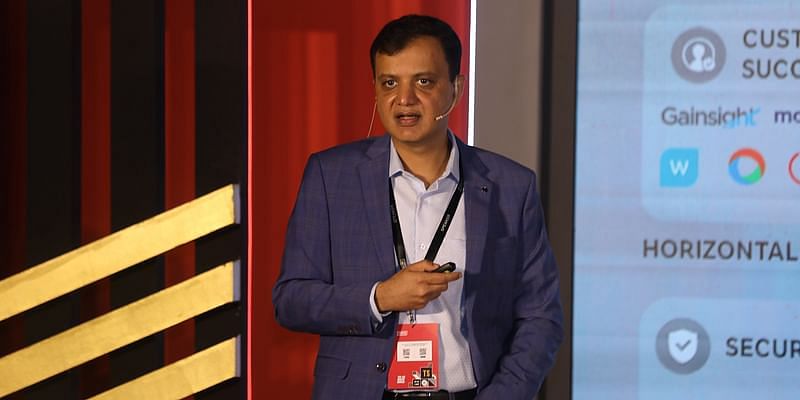In an era where consumers are spoilt for choice, businesses need a go-to-market (GTM) strategy that cuts through the clutter, especially when it comes to SaaS.
Enter Rakuten India, the global product and innovation centre of Rakuten – the largest ecommerce company in Japan, and third largest ecommerce marketplace company worldwide.
Rakuten India is the largest among Rakuten’s nine technology hubs outside Japan. It has been an important tech hub for developing solutions for Rakuten’s global ecosystem of more than 70 diverse businesses and 1.6 billion members, serving users worldwide through businesses based in 30 countries and regions.
As the Rakuten Group leverages its expertise and expands into B2B technology products, Sunil Gopinath, CEO, Rakuten India spoke about how to build your GTM with a laser-sharp focus on the customer, at a keynote at TechSparks 2022, India’s most influential startup-tech event.
Helping brands stay competitive with SaaS for ecommerce
Drawing from Rakuten’s global ecosystem of more than 1.6 billion members, Sunil spoke about one of its flagship products for ecommerce players – Rakuten Senjutsu, designed to help brands stay competitive with SaaS.
“If you’re an ecommerce company of any kind, from any geography, having a competitive intelligence platform that feeds you strategic intelligence on the breath, pricing, quality and other factors on your platform vis-a-vis your competitors, can be a powerful edge in a competitive market,” he said.
Rakuten Senjutsu, which is now available as a SaaS product works agnostic of business verticals, and can help ecommerce players with closing the product and price gaps, AI-based product matching engine, insights into brands, merchants and campaigns from competition, bridging online offline purchase flows, and more. “Having a ready-made go-to tool like this can add enormous value especially for a new ecommerce player,” he added.
Leveraging the power of data and AI
Sunil also spoke about how Rakuten Knowledge Graph can help brands leverage the power of data and AI for contextual recognition of customer needs, purchase decisions, customer loyalty and expansion, among other things.
Having distilled the insights from Rakuten’s 70+ global businesses, 50,000+ merchants, 360 million products and items and 100+ million customers on a daily basis, Rakuten Knowledge Graph can be yet another key enabler for ecommerce players.
“The product knowledge graph is non-negotiable in the ecommerce space, and the Rakuten Knowledge Graph is built to help with identifying various brand synergies. These include intelligence on which brand(s) of shoes a user is more likely to buy depending on their previous purchases, forecasting consumer’s design and colour preferences with cross-category compatibility forecasting, and much more,” he said.
Rakuten Knowledge Graph comprises two sub proprietary brands: Rakuten PJG – which covers brand discovery, catalogue relevancy, and accurate and intuitive searches; and Social Graph, which covers family clustering, expansions, credit scoring, predictions, target prospecting and more can serve as a powerful recommendation tool.
Dramatic cost reductions for mobile networks
Mobile networks to date have been dependent on dedicated hardware. Rakuten Mobile has taken a different approach, utilising virtualisation technologies to disaggregate network hardware and software. The network runs on general purpose hardware, which has enabled dramatic cost reductions.
Traditional outdoor base stations feature a large number of components. By moving the radio access functions to data centres, Rakuten Mobile has been able to simplify and reduce the footprint of its base stations. This allows for greater freedom and flexibility in deployment and significantly reduces construction and operations costs.
“Rakuten Mobile’s fully virtualised cloud-native mobile network has resulted in 40 percent CAPEX and 30 percent OPEX reduction,” he said.
The AI-powered lookalike model for customer acquisition
Customer DNA is Rakuten’s AI marketing tool which empowers marketers to acquire new customers more efficiently, utilising Rakuten’s membership data and science. The tool has 2,000 attributes built-in of which 100 are core attributes and 1,900 derived attributes.
“One of the unique features of Rakuten data is that we have purchasers’ data. Who buys a certain product is information that’s more credible than other marketing insights,” he said.
“Customer DNA can not only provide the list of purchasers in Rakuten, but it will also come up with the list of users who are similar, hence likely to buy the product. The intelligent target prospecting component on the tool ensures that the right set of customers are contacted with the right content and at the right time,” he added.
Game changers for conversational AI commerce
Sunil also spoke about conversational AI commerce solutions at Rakuten called Speech Factory that brought model development to deployment time down to three weeks while significantly reducing model development and operational cost. Built best-in-class domain, Speech Factory delivers specific speech models at scale with an end-to-end platform for domain-specific speech models, automated model customisation, benchmarking, and production monitoring.
The prescription for healthy infra
Each of Rakuten’s 70+ businesses has a minimum of 1,000 microservices each running at any given point of time producing 100s of petabytes of data on a weekly basis.
Rakuten’s application process monitoring tool helps businesses gain a 360-degree view of their applications with Site24x7 APM. It also enables them to achieve end-to-end observability by tracking key application performance metrics to monitor and optimise the performance of your application in real-time with a scalable, AI-powered, full-stack monitoring solution.
“All of this comes with full transparency of what AI is doing in the backend with a cognitive machine that facilitates validation as customers help the ML algo learn,” he said.
“The tool also has forecasting capabilities for better preparedness in terms of reducing losses that have occurred in the past due to unknown unknowns, and segregating the bad anomalies from the expected ones. All this, in a system that’s proactive, reactive and auto-healing,” he added.





![Read more about the article [Exclusive] Turmoil in Glamyo Health after employees allege delay in salaries, potential bankruptcy](https://blog.digitalsevaa.com/wp-content/uploads/2023/06/PrystynLayoffsCoverLite-1678259017304-300x150.jpg)


![Read more about the article [Funding roundup] Leaf Round raises $300K, Sat Industries backs 18 early-stage startups, Pine Labs invests in Mosambee](https://blog.digitalsevaa.com/wp-content/uploads/2022/04/Featureimages-newdeck13-1641292542575-300x150.png)


